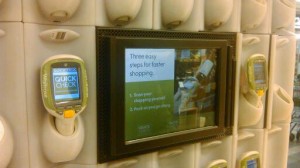How to make it personal with technology
 Two things seem to be on retailers’ minds these days – personalised shopping and the technology that can deliver it.
Two things seem to be on retailers’ minds these days – personalised shopping and the technology that can deliver it.
There is a balancing act to be had here that must be right in order for the two to successfully work hand in hand. For a business to provide a personalised service it needs to be customer centric while not being overly invasive or equally too self-aware. As technology glistens in the eye of the retailer the challenge is to stay away from the benefit to the business, and to focus instead on the customer need and the technology that can provide it.
Although still in the early stages of development several retailers are beginning to express an interest in delivering a more personalised shopping experience. In doing so, six trends are appearing surrounding convenience, enjoyment, interaction, benefits, friendliness and control.
We take a closer look at the trends and the retailers experimenting with ways to make it personal with technology:
Offer convenient services – A personalised service should ultimately make the consumer’s life easier and fit in with their life style, like click and collect along with the lockers and changing rooms. For example Asda took its personalisation outside by fitting in with its customers life styles as well as what they are buying. The supermarket used the power of convenience when planning its 1,000 practically located shopping pick-up points across the country that include temperature controlled lockers which cater for dry, chilled and frozen goods.
Make shopping with you enjoyable – If you are going to make something personal it should be a positive experience for the customer that brings a smile to their face. The digital Christmas list app from Argos has focused on bringing a touch of personalisation to its sales, but in a nice way. Its smart phone and tablet app allows children to build a list for Santa Claus, complete with the child’s name and photo as well as an animated character. The list links to 3,000 toys that are on sale at Argos which the child can choose from and then share with friends and family via their parent’s email account.
IKEA’s ‘motivational mirrors’ are also a great example of a positive experience. In an effort to make its customers have a feel good shopping experience IKEA tested interactive mirrors in store that would compliment the customer as they passed by or stopped to check their reflection, saying things like “Suits you sir”, “Wow, you have been working out” and “Darling your dress looks amazing”.
Interact with your customers – One to ones with the customer whether it’s in store or online are a great way to build a relationship, and the best relationships for retailers are ones that they can learn from. Take John Lewis department store for example that is using omni-channel projects to reach its customers on a more personal level. Transactional tablets are operating in store while running a selling app to help sales assistants to turn a product enquiry as to what they should buy into a sale, as well as a means to collect key customer information. Retail director at John Lewis, Andrew Murphy, explained that the store is particularly interested in “understanding more about trying to capture customer’s browsing journey in store” rather than making assumptions based on their online experiences only. For example Andrew explains, “if someone’s in a store looking for a washing machine, a sales assistant can talk them through the selling journey, but record the browsing steps on the tablet and record that data”.
Provide a benefit – If a customer can feel the benefit of coming to your store over another you are on to a winning retail strategy. At Waitrose’ new Salisbury store technology and a relaxed shopping experience go hand in hand. Its modern supermarket includes a number of technology influences that Waitrose believes will work well in this internet age, by encouraging dwell time and making the store more than just a place to shop. The store features changing areas that support its click and collect clothing purchases from John Lewis by allowing customers to try things on before they take them home. While, touch screens, particularly in aisles where the consumer is likely to make a more considered purchase such as wine to accompany a meal or occasion, are used to provide additional product information.
Be friendly – Service with a smile still goes a long way. Bringing personalisation to life in store also is US brand American Eagle Outfitters that has recently opened in the UK, that uses digital call buttons in its fitting rooms and requests a shopper’s first name as part of its personalised service. Other customer facing digital technology in the store includes iPads and large format displays.
Put your customers in control – Giving your customers the power and trust to personally manage all stages of their shopping process is a great example of a truly personal experience. Self-service tools like scanners, kiosks and till points enable customers to price check, scan, buy and pack products without staff assistance. Waitrose’ self-scanners for example allow shoppers to scan and pack goods in their own time as they shop, then when it comes to paying customers can choose from a traditional manned till point or a self service one to close the transaction, both of which are a much calmer payment experience as no frenzied packing is required.
It is expected that going forward we will see retailers experimenting more frequently with digitally led interactive customer journeys with a particular focus on mobile.


No comments yet.